Breeding guinea fowl is not only fascinating because of the unusual nature of such birds, but also brings good profit.
Guinea fowl: description and characteristics of the bird
A close relative of turkeys, quails and domestic chickens, the guinea fowl is unpretentious in maintenance, resistant to diseases and gets along well with other inhabitants of the house. It is for these reasons that the cultivation of guinea fowls in a private household is gaining more and more popularity.
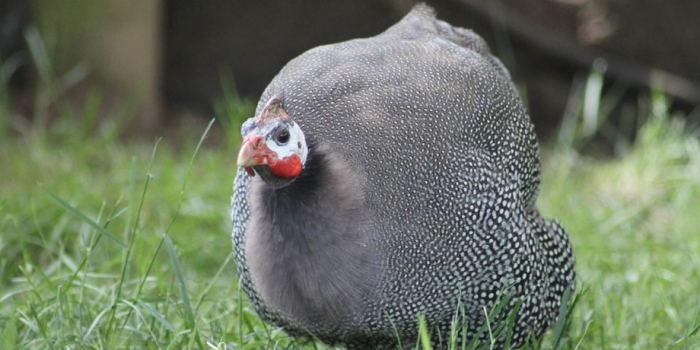
A native of West Africa with its warm climate, such a bird feels great on the territory of Russia, having adapted to unusual, less sparing climatic conditions. With proper care, the guinea fowl is able to withstand very severe frosts.
Outwardly, the feathered bird resembles a turkey and chicken combined; small bared head with original jewelry, short neck, long oval body, pockmarked plumage. The average weight of an adult female is usually about 1.8 kilograms, the male reaches 2 kg. More than 20 species of guinea fowl are known, divided by color into blue, white and gray. White breeds are considered to be the most egg-laying; in order to obtain meat, more attractive gray and blue birds are mainly grown. Shows the beauty of such a guinea fowl photo.

Breeding such a pretty bird is not particularly difficult. It is only important to ensure her proper care in order to receive the highest possible return from her.
Why guinea fowl?
Breeding guinea fowl at home has certain advantages.
- Meat. Dietary and nutritious, it is in great demand among consumers. At the output, its mass in its pure form is 85%, which is considered a fairly high indicator, with 20-22% being the brisket. It tastes like pheasant or black grouse meat, contains little fat (about 4%) and a lot of biologically useful substances (even more than in chicken meat).
- Eggs. Tasty and healthy, contain a high percentage of magnesium, manganese, lysine, carotene, do not cause allergies and are characterized by a long shelf life; thanks to a strong thick shell, they are able to lie in the refrigerator for about six months or more. On sea-going vessels, this “perpetual product” is simply an indispensable ingredient in the kitchen menu. Only quail eggs can compete in taste. One individual is capable of laying up to 120 eggs per year, each weighing 40 grams (slightly less than chicken, which usually happens between 55-60 grams).
- Attractive appearance. The bird looks very worthy in the household, looks decorative, so many plant it as a curiosity, a kind of decoration of the farm.
- High adaptability to climatic conditions. Guinea fowl calmly refers to local climatic conditions, withstands severe frosts. Even in an unheated house, the survival rate of young animals is 98%.
- Precocity. Breeding guinea fowls, characterized by rapid mass gain, is aimed at their implementation within 45-50 days after hatching.

At the origins of business
Where to start such a home-based business as breeding guinea fowl? First of all, it is required to purchase healthy young growth (usually of a day old age), when buying it, special attention should be paid to the appearance of the chicks: chicks should be confident in their legs, have soft even fluff, and have wings pressed to their bodies and clean buttocks. Healthy individuals have a good response to sound: if you lightly tap on the box, they will react noisily.Young animals should be purchased from trusted reputable companies specializing in poultry farming. When planning a guinea fowl breeding business, it is advisable to buy at least 20 goals for the subsequent selection of the best specimens and the formation of a high-quality parental herd in the future. For breeding work, the bird is selected at 6 months of age. Females differ from males in the following way: males have a bright small tubercle above their beaks, directed upwards; in the female he is almost invisible.
Guinea fowl: breeding and keeping at home
After the purchase of young guinea fowl, the next step is the direct process of their cultivation, for the effectiveness of which a number of certain conditions must be observed.
Guinea fowl (breeding and keeping them is not too troublesome) need a dry and warm room, without drafts, because birds, given the constantly walking wind, can catch a cold even at a temperature of +15 aboutC. For 1 meter, the square density of the hens should be no more than 10 goals. When guinea fowl are kept in cages, the mesh installed in them must have a non-smooth continuous coating that ensures normal movement of the bird.
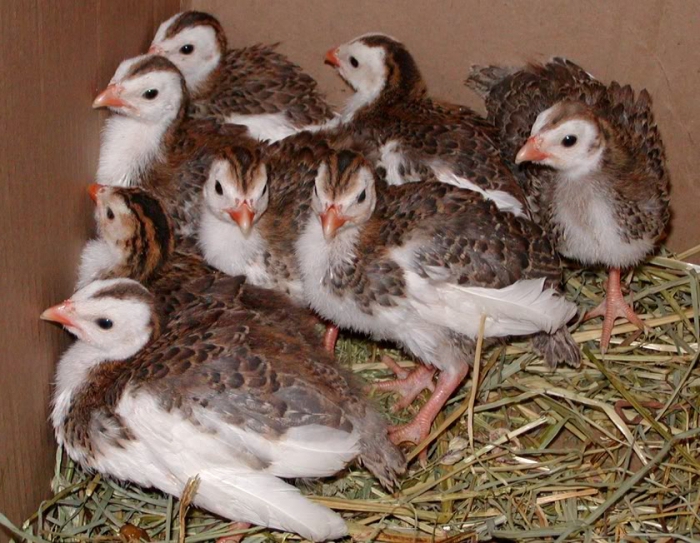
It is not recommended to use a nestling net to prevent injury. Perches (5 guinea fowl - 1 linear meter) are required to prevent the bird from sitting on the floor, which, by the way, should be covered with dry litter (sawdust, wood shavings, straw). Change the litter once a month. In winter, it is required to provide the bird with long-term lighting (turn on the light at 7 am and turn it off no earlier than 22 hours).
Guinea fowl conditions
Each cage should be equipped with a feeder and a drinking bowl, in which the presence of clean and fresh water is a prerequisite. This is especially true of the summer period. Otherwise, the bird may get heat stroke. Cleanliness is one of the main conditions for guinea fowl, so cages, feeders, drinking bowls should always be cleaned in a timely manner. The house requires regular disinfection every 3-4 weeks, because guinea fowl are very sensitive to all kinds of parasites, namely salmonella, E. coli, and helminths. However, if the bird is sick, then the likelihood of curing it is minimal, so in any case, the disease is better to prevent than to allow. If there is a risk of infection of the latter, veterinary vaccination is required, isolating from the general herd of infected individuals.
Broiler guinea fowl, breeding of which is carried out by analogy with broiler chickens, is completely not picky about the conditions and place of keeping, and it can be placed next to other types of poultry. The bird is free by nature, therefore, it requires a lot of free space, without which it will slow down in weight gain and may stop flying. For optimal weight gain and high egg production, do not mix guinea fowls of different groups, otherwise they will start to fight and compete for food.
Oh, those noisy guinea fowls!
Guinea fowl should also be provided with special tanning salons - illuminated places where they can go out to bask. A shadow should also be present in the aviary. From neighbors it is advisable to enclose a high net (at least 2 meters), because guinea fowls fly very well. In the walking area it is recommended to plant shrubs and put a small canopy. Guinea fowl, breeding of which is not particularly difficult, are very shy by nature and react violently to any rustle or slightest movement. Therefore, the formation of adequate bird behavior should begin at a very young age. A peculiarity of guinea fowls is their intolerance to the education of their own offspring, very often the females leave their eggs even before the appearance of the chicks.
Features feeding guinea fowl
Guinea fowl are the most desirable bird for food, because they eat almost everything: greens (half the daily diet), feed, fruits, vegetables, root crops, food waste. Guinea fowl, whose breeding is gaining popularity in the household, prefer to spend most of their time on green pastures, therefore, significant savings in feed, especially in the summer, is the primary factor in starting your own business for growing guinea fowls.
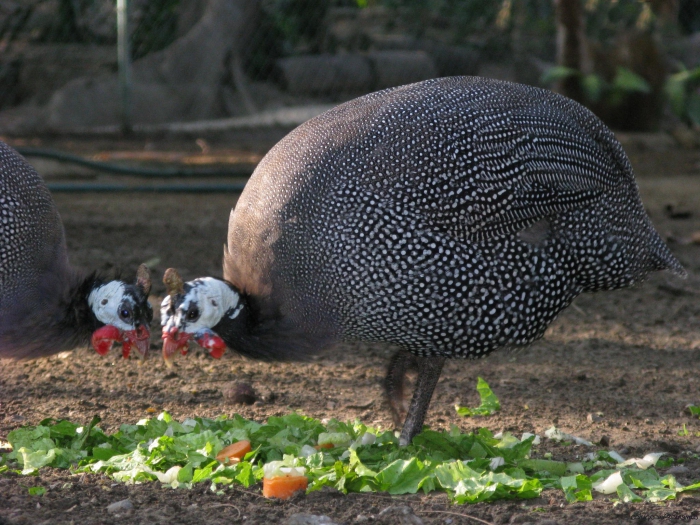
Feeding poultry 3-4 times a day. Optimally, if the feeders are always filled with food, so that the guinea fowl can feed on demand. As a useful supplement for maximum assimilation and digestion of food, guinea fowls are recommended to give vitamins, fish oil, chalk and eggshells containing the necessary calcium. Animal feed is also necessary for guinea fowl; they use it in the form of worms and slugs found.
In cold weather, the bird should be fed more carefully, add fish oil, sour milk and meat waste to wet mixers. At night, feed and grain should be given. Under comfortable conditions, the bird rushes almost all year round.
How to breed guinea fowl
Breeding guinea fowl is not particularly difficult. 5-6 females are usually left for one male (it is desirable that he is several months older than his ladies). It is important to remember that pairing and breeding guinea fowl at home, described in detail in this article, occurs subject to their complete freedom. Premises for such a responsible business, the bird does not recognize. It is noteworthy that the cultivation of guinea fowl on a home yard does not require the obligatory presence of a male who may become ill or be too pugnacious.
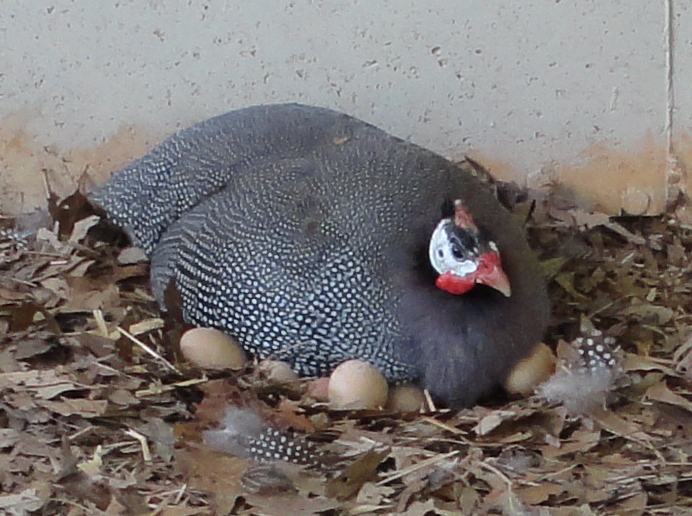
The female is able to carry fertilized eggs for another 20 days without his presence. Egg production decreases at the 3rd year of life, therefore, the use of poultry for 2 years will be optimal for breeding guinea fowl.
During masonry, which begins at the guinea fowl in late February, females look for secluded places, so during this period it is recommended to release them into the pen from morning to noon. Fertilized eggs should be taken in the morning, laying them in a prepared container with a blunt end up or placed under laying hens or turkeys. Then the offspring that appears will be more tame and non-slavish. Oviposition can last more than six months. The maximum hatching period is 26 days.
Breeding guinea fowl in an incubator
Breeding guinea fowl in an incubator is similar to raising chickens. Before laying eggs, the incubator needs to be warmed up to 38 degrees, after which eggs should be laid, which for convenience of turning can be marked on both sides. The first rotation, aimed at improving the heating of the embryo, preventing its adhesion to the shell, is made 12 hours after laying. This procedure is required to be performed 6 times a day. From day 1 to day 13, the temperature in the incubator should be 37.8 aboutC at a humidity of 60%, from the 14th to the 24th day - 37.5 aboutC at a humidity of 50%. Starting from the 6th day, it is required to cool the eggs once a day by opening the incubator lid for 5 minutes. After 2 weeks, increase the cooling time to 10 minutes. 3 days before the hatching, the eggs are turned over and cooled.
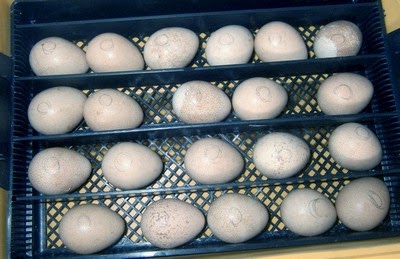
On the 26th day, egg hatching begins, the temperature at this time should be 37 aboutC at 96% humidity. Hatching of guinea fowl chicks, breeding in the incubator of which is characterized by a high percentage of offspring, occurs on the 27th day.
Offspring Care
The most optimal time for growing young animals is April-July. It is important in the first day of hatched chicks to trim on the wings of the brush. This is due to the fact that guinea fowls fly well and are able to calmly overcome neighboring fences.
The diet of babies in the first 10 days of life consists of a mixture of chopped green onions, egg yolk and cottage cheese.As a drink, you need to give yogurt or whey. The optimal diet for guinea fowl will be chopped feed for broiler chickens. For herbs (alfalfa, nettle, clover, ordinary grass), you can begin to transfer from 5 days of age.

At first, the nutrition in babies should be 8 meals a day. Closer to a month old, feeding can be done 5 times a day, starting from 2 months - 3-4 times will be enough. The chicks always need a lot of water, the first time it is possible to soak the feed in it, because it is difficult for chickens to digest them dry, in addition, they can simply choke. For example, in the morning you can give dry food, in the afternoon - a wet mash, in the evening it is dry again. In the fifth week of the growth of young guinea fowl, you can transfer to the grain mixture and waste, flour, bran; this is required to be done gradually.
Guinea fowl, breeding at home which can become a farmer's favorite pastime, at a young age the bird is nimble and eats food quickly, but restlessly, therefore feeding is recommended to be done in small portions in an oblong feeding trough, which will ensure complete eating of the food and access of the whole bird to food.
The conditions for young animals
From 2-3 months of age, babies should be allowed out for a walk, this will give them the opportunity to learn how to get food on their own, looking for different bugs, larvae and worms in the ground; in the enclosure a drinker and feeder must be present. All guinea fowl come home at the time of feeding and before dark. Young animals should be kept in the cage for the first few weeks, the surface of which should be covered with paper so that the feet of the babies do not fall out. In the room, the litter changes twice in the first week. Further, when the paws of the kids grow up and they stop falling into the mesh cells, the paper can be removed, which will simplify cleaning. Under the cage, you just need to put a pallet where all the litter will wake up.
The state of the chicks can be judged by certain signs of their behavior. If they are piled up, then you should add heat to the room. If they lie relaxed, with their wings spread, it means that you need to reduce the temperature. For young animals up to 10 days of age, 30 will be comfortable aboutC, from the 11th to the 20th day - 27 aboutC, by the age of one month - 20 aboutC. That is, as the chickens grow older, the temperature should be gradually reduced, bringing it to the norm of an adult bird.
To control the growth of young animals, it should be periodically weighed. The weight of the daily chicken should be 30 grams, 2-month-old 850 grams, 84-day - 1.2 kilograms.
Guinea fowl on the homestead - out of competition
Guinea fowl is a cultural bird, and if it accidentally appears in the garden, it will not rake the beds and spoil the crop. Her attention will be taken by pecking Colorado beetles, worms and other insects.
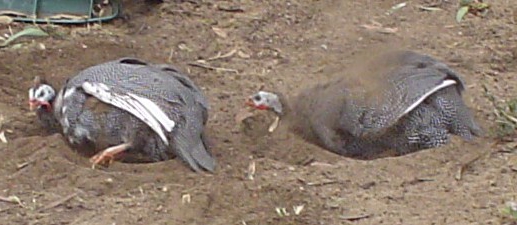
Guinea fowl, the breeding and maintenance of which at home is a bother, in addition to the hassle, know their flock well, stay in groups, quickly get used to the owner and distinguish his voice. When he appears in the yard, an incredible noise and scream is immediately raised, which is perhaps the only minus of such a bird (its excessive loudness). Like hens, they like to dig in the ground, so on a walking platform it is recommended to pour a bunch of sand in a complex with ash, in which the bird likes to swim.








